
A passenger watches the scenery roll by on Thunder Bay's 3M Memorial bus route. Public transit ridership is disproportionately Indigenous in a city where transportation options depend very much on race and class.Photography by Melissa Tait/The Globe and Mail
On Thunder Bay’s official crest, there’s a picture of a canoe, and in the canoe seven men in blue shirts sit around one man dressed in black.
Starting in the 17th century, merchants seeking beaver pelts travelled up the St. Lawrence River and through the Great Lakes to what is now Thunder Bay. They took the trip in 36-foot canoes made of birchbark with payloads of 6,000 pounds, paddled by French-Canadian and Indigenous voyageurs, while a Scottish fur baron, known as a bourgeois, sat passively in the middle.
These were the men in blue, and the man in black.
They survive as a relic on the municipal crest, a celebration of the city’s founding industry. But they also illustrate hierarchies of power and mobility that continue to define Thunder Bay, where transport plays an outsize role in shaping daily life and putting people in their place.
Then, as now, if you wanted to understand this divided city in the middle of the country, look at how people get around.

Thunder Bay's coat of arms, shown in a fountain at City Hall, shows a fur-trade-era voyageur at left and, on the shield, a great canoe with seven paddlers and a Northwest Company agent.
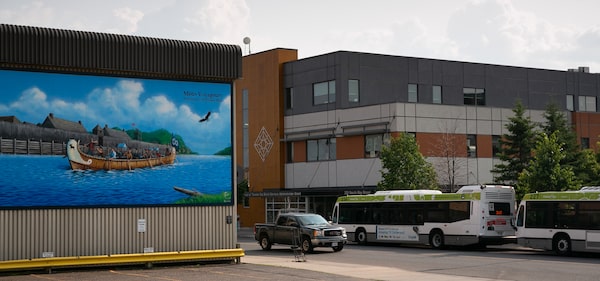
Voyageur imagery is ubiquitous in Thunder Bay, whose parent cities of Port Arthur and Fort William were important hubs for settler travel. Today, the severing of many bus and rail links to the rest of Canada has left it isolated, except with those who can afford to fly or take a long road trip.
Public transit is often treated as an afterthought in Thunder Bay. Just 4 per cent of the city’s residents commute by bus, according to the 2016 Census, compared with the 88 per cent who travel to work by car or truck. Brad Loroff, the city’s transit manager, acknowledges that most of his riders are “not travelling by choice, but travelling by need.”
People in need here are disproportionately Indigenous, and the bus reflects that. The public service announcements posted above the rows of seats this spring included a helpline for Indigenous women and an anti-racism program (“Respect. It begins with you and me”).
The fact that the bus is essentially an Indigenous form of travel has made it a locus of racism. The transit authority gets periodic complaints from people who feel bus drivers have refused to pick them up because of their skin colour. “It’s a concern,” Mr. Loroff acknowledged.
For Autumn WhiteFeather, it’s more than a concern. This spring, the young First Nations woman wrote on Facebook about an incident in which a bus driver asked her to turn her music down, although she was wearing headphones, and then gave her misleading directions. She feels his behaviour was racially motivated. “This wasn’t the first time I had a run in with him,” she said in a message to The Globe and Mail. “He is very racist towards the natives and East Indians especially.”
Ann Magiskan, the city’s aboriginal liaison officer and a member of Lac Seul First Nation, sometimes rides the bus just to keep an eye out for bigotry. She herself has been mistreated on public transit because of her ethnicity, she believes: She accidentally flashed an expired transfer while boarding a bus recently, and the driver responded with undisguised suspicion. “The lady says, ‘This is no good, this is from yesterday. Are you trying to scam the bus?” Ms. Magiskan recalled. “I looked at her and said, ‘Scam the bus for $2.75? I work out of the City Hall building.’”
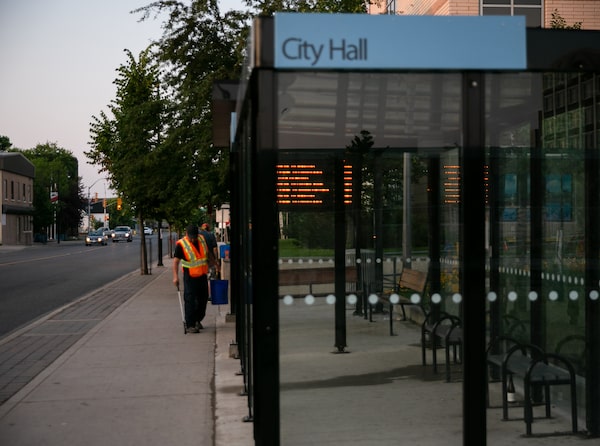
A worker picks up trash outside the City Hall bus terminal.
Moments of hostility are compounded by an overall neglect of the transit system by a car-dominated city. In 2010, the indoor Brodie Street bus terminal – a popular meeting place for Indigenous youth – was torn down to make way for a new provincial courthouse.
The new terminal outside of City Hall is open to the elements and, although its stand-alone shelters have on-demand radiant heat, Mr. Loroff admits that the technology “doesn’t work so well when the temperatures plummet to like minus 20” – which in Thunder Bay they often do. Meanwhile, at many stops, there are no shelters at all.
Thunder Bay Transit is also looking to scrap a bus route that covers the neighbouring Fort William First Nation reserve, citing low ridership figures.
If council approves the plan, the so-called Mission route – which alludes to the reserve’s history as a Jesuit mission in the 19th century – will be losing its regularly scheduled buses in favour of smaller, on-demand vehicles.
At a public consultation in February, Mr. Loroff found that some riders were “scared” by the proposed change. “They say, ‘I don’t want to lose my transit service!’,” he recalled. “We tell them, ‘You don’t have good transit service now.’”
It’s not just the Mission route: No one in Thunder Bay has particularly good transit service. More heavily trafficked routes are often cumbersome and slow. A bus trip across town can easily take more than an hour and require several transfers, in a place where virtually nothing is more than a 15-minute drive away.
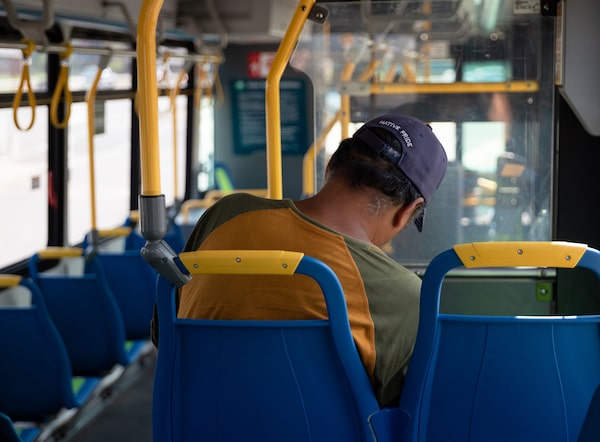
Bus trips across Thunder Bay can be a time-consuming process requiring multiple transfers.
Money is part of the problem. While the city spent nearly $16-million on roads in its 2018 budget, it provided more than $12-million for transit. When asked why he didn’t ask council for more money to provide better service, Mr. Loroff balked.
“So, [I] can come back at budget time and put [my] head on the chopping block and ask for that,” he said.
The bus’s low standing on the municipal agenda was in evidence during a city council meeting in May, when the chamber discussed an application for newly available federal transit funding. When it was Mayor Bill Mauro’s turn to speak, he said he was concerned that the city would be on the hook for more spending of its own if it accepted the package from Ottawa.
“There comes a point at which, how much more transit money can we use?” he said.
The concerns of drivers take up a much bigger share of the city’s political oxygen. Potholes are a particular obsession. The weekend newspaper is full of reader complaints about them, and until recently “Report a Pothole” was the most prominent feature on the City of Thunder Bay website; visitors looking for “Aboriginal Relations” had to scroll down.
If you can afford to, you drive in Thunder Bay. Preferably something big. Pickups and SUVs are so common that even people who drive a regular car simply call it their “vehicle.”
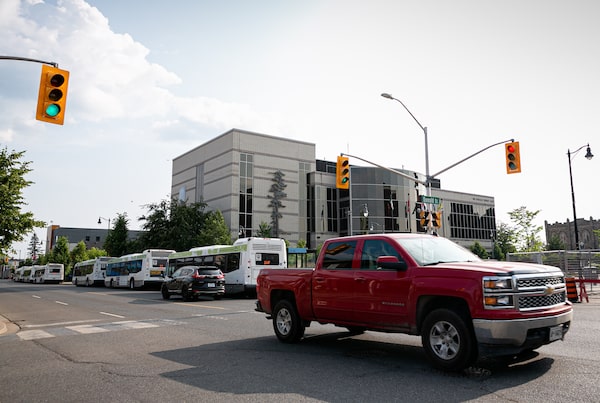
In Thunder Bay, pickup trucks are an essential accessory for the middle-class motorist.
While trucks are popular in many smaller cities with poor public transit, they are at a particular premium in Thunder Bay. That is in part because of the city’s proximity to nature and the local popularity of off-road driving, but also because of the unusual, split nature of the place. Until 1970, Thunder Bay was comprised of two cities, Fort William to the south and Port Arthur to the north. To this day, both downtowns remain, with a long stretch of strip malls and heavy industry between them, making driving by far the most convenient way to get around.
Four wheels and a flatbed may be king in Thunder Bay, but they’re also expensive, and many low-income Indigenous people bike instead. That leaves them open to different kinds of abuse. On one hand, the ubiquity of Indigenous cyclists has given birth to a racist trope. Travis Hay, a historian at Lakehead University, cringes as he tells a joke he heard often while growing up in Thunder Bay.
“What does an Indian get for his birthday?” it goes. “Your bike.”

Cycling in Thunder Bay can be risky, both for those facing anti-Indigenous racism and for those navigating paths and streets that aren't very bike-friendly.
On top of prejudice, Indigenous cyclists have to contend with a dangerous lack of biking infrastructure. The city boasts 42 kilometres of bike lanes and “shared” bike and car lanes, but many of them wind through leafy residential streets, and bike riders on arterial roads usually just resort to the sidewalk, when there is one.
When collisions happen between a car and a bike, as they inevitably do, the police sometimes seem to blame the victim. Jeff Moorley, a lawyer at the personal injury firm White Macgillivray Lester, said he has seen cases where a cyclist was hit by a car, then charged with biking on the sidewalk.
“It adds insult to injury,” he said.
The same sort of double jeopardy awaits pedestrians in Thunder Bay. In February, 2017, an Indigenous woman was struck by a car while crossing the street, leaving her with a broken leg and a concussion. While she recovered in hospital, a police officer brought her a ticket for “entering the highway unsafely,” according to a report last year from the provincial Office of the Independent Police Review Director.
Walking the streets in Thunder Bay as an Indigenous person can be fraught in many ways. Stories of white men hurling garbage out of their car windows at pedestrians are common. In February, 2018, the occupants of a silver hatchback drove through the city shouting racist abuse and pelting Indigenous people with eggs, sending one man to the hospital.
The consequences of these attacks can be severe. Barbara Kentner, a 34-year-old Indigenous woman, was walking home with her sister in the early morning of January 29, 2017, when she was hit in the stomach by a trailer hitch thrown from a passing car. Her sister said that one of the passengers yelled, “I got one,” as the car drove away. Ms. Kentner died several months later, and a young white man named Brayden Bushby was eventually charged with second-degree murder in the case. He is awaiting trial.
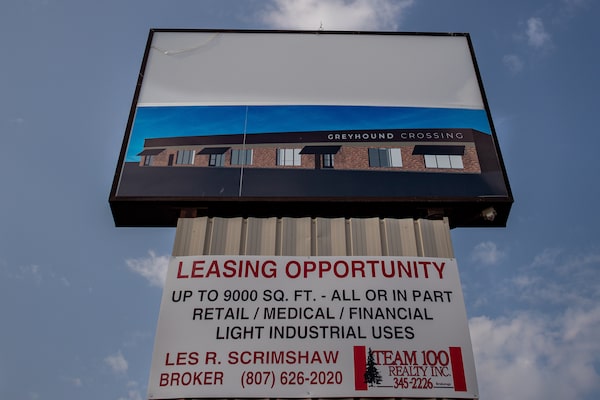
Thunder Bay's Greyound terminal, once a gateway for lower-income Thunder Bay residents to leave and return to the city, is now up for lease. Greyhound scuttled routes across Western Canada last fall, and now the only bus service out of Thunder Bay is through the company Kasper, which only services nearby small towns.

Even for those who have vehicles, getting out of Thunder Bay is a long haul, with hundreds of boreal forest standing between them and the nearest big cities in Ontario or Manitoba.
Thunder Bay is almost exactly halfway across Canada: about 4,000 kilometres of highway driving from both St. John’s, Nfld. in the east and Whitehorse, Yukon, in the west.
Historically, that central location has made the city a crossroads, from its use as an annual rendezvous point for fur traders in the 19th century, to Thunder Bay’s role as a trans-shipment point for Prairie grain heading east in the 20th.
Today, though, the city’s place on the map can feel less like a nexus and more like a confinement. Simply put, it’s easy to become stuck in Thunder Bay. Frequent coach service once linked the city to the wider world, but the last Greyhound bus pulled out of the station last fall, part of a corporate retrenchment across Northern and Western Canada. (Now, an upstart company called Kasper offers the only local bus service, and then only to nearby destinations such as Longlac and White River.) The train isn’t an option for leaving town either: Via Rail cancelled passenger service to Thunder Bay in 1990. Today, a husk of one of Via’s distinctive yellow and blue railcars sits on display along the banks of the Kaministiquia, part of the Kam River Heritage Park, along with an old tugboat.
Historically, hitchhiking has been one way for low-income people to leave town, but that comes with serious risks, and can have deadly consequences for Indigenous women, especially. In 2017, a woman named Diane Geissler testified at the national inquiry into Missing and Murdered Indigenous Women and Girls. She described how her mother, Kathleen McGinnis, tried to hitchhike from Thunder Bay to British Columbia in the late 1970s, in search of her son, who had been apprehended by a child welfare agency. Ms. McGinnis was found dead along a highway near Calgary.
Even people with the means to come and go freely can be struck, while travelling, by Thunder Bay’s haunting remoteness. Hundreds of kilometres of boreal forest, lake and Canadian Shield stand between them and the next city of any size.
That space was once traversed by voyageurs and bourgeois in birchbark canoes, a journey that helped knit the country together by making its expanses feel smaller. But distance is distance, and today it is never more stark than when seen from the sky, at night.
“You don’t really realize how isolated you are, here, until you fly in the dark,” said Brad Loroff, the transit chief. “When you take off, it takes a while before you see lights … You’re in the dark for a while.”
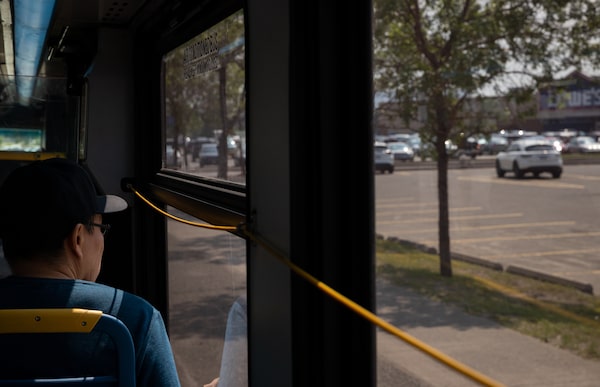
Our Morning Update and Evening Update newsletters are written by Globe editors, giving you a concise summary of the day’s most important headlines. Sign up today.
 Eric Andrew-Gee
Eric Andrew-Gee